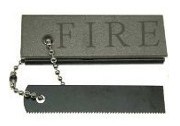
 Many of us have the tendency to think that we will never face a really serious disaster or emergency. But those who have been through a difficult ordeal know that it is those who are prepared that have the best chance to survive a crisis.
Many of us have the tendency to think that we will never face a really serious disaster or emergency. But those who have been through a difficult ordeal know that it is those who are prepared that have the best chance to survive a crisis.
This article is the first part in a three part series on how you and your family can be prepared if disaster or emergency strikes.
It is not difficult. In fact, it can be easier than you think.
In this guide, we break the preparation process down into 4 checklists. Begin with step 1, and work your way through step 4.
Step 1 – Build an emergency pantry that can provide you and your family with food for a year. I know that sounds like a lot. But it is much better to be over prepared than under prepared. You will want to only buy food for your emergency pantry that will keep very well. Ideally you will want to stock it with food that can keep for several years. This emergency food pantry will give you peace of mind that if disaster or emergency does hit, you and your family will have plenty to eat. Consider it to be an insurance policy. We take out insurance against all kinds of disasters that might happen. It is very good to have some “food insurance” as well.
Step 2 – Once you have your main emergency pantry, start work on a “working pantry”. In your “working pantry”, you will regularly rotate your food so that you eat the oldest first and that way your working pantry stays fresh.
We will discuss steps one and two more further down in this first article.

Step 3 – You will want to make a plan for what you and your family will do for water in the event of an emergency. This usually involves a couple of considerations. Number one, it is always good to have at least a small supply of water stored away in case of emergency. Secondly, you need to have a plan in case your current supply of water is cut off. We will discuss this step quite a bit more in the second part of this series.
Step 4 – This final step involves preparing your home in case you are out of power or you can’t get to the store for an extended period of time. There are practical steps that you can take right now to prepare your home for an extended emergency situation. We will discuss this in the final part of this series.
Getting back to building an emergency food pantry, one of the best things to do is to stock up when you see food items on sale. If you pay full price for everything, building an emergency food pantry is likely to stretch your budget a little too thin. If you wait to buy your emergency food when it is on sale, it will be much easier on your budget.
Checklist 1
Consideration 1 – You will need to gather some metal containers, or durable plastic containers that mice cannot chew through.
Consideration 2 – Oxygen absorbers are great for keeping your food from going stale, so get as many as you think you may need.
Consideration 3 – Think about where and how you will store your food. It is best to have a dedicated area for your emergency food pantry, and it is suggested that this dedicated area be in a clean, dry place.
When you are building your emergency pantry, it is a good idea to try to focus on foods that are dried or freeze dried if possible.
The following are some suggested foods for your emergency pantry…..
Nuts- Almonds, Walnuts, Pecans, Cashews
Granola
Instant Oatmeal
Instant Rice and Potatoes
Dried Soups
Spaghetti- Spaghetti is perfect because it stores flat. You can buy 300 packages easily, and it doesn’t take up much room.
Dried Beans
Wheat
Dried Meats
Canned Peaches, Canned Pears
Dried Fruits- Buy yourself a dehydrator and you can do this yourself.
Crackers
Granola Bars
Dry Cereals
Peanut Butter
Dry milk
Powered Juices
Once you have established your long term emergency pantry, you will want to focus on building your “working pantry”…..
The goal is to store up a one year supply of food in your working pantry, and to rotate and use the food in that pantry.
As you go to the grocery store, grab a few extra items each time and slowly build it up. You don’t have to do it all at once.
In addition, you can store food grown in your own garden and add it to your working pantry.
The goal will be to add food back to your working pantry as you eat it. Always try to keep about a one year supply of food on hand.
If you follow these steps, you will not only have plenty of food for your and your family no matter what emergency may come, but you will also have plenty to share with others. Being able to help others in a time of great need can be a tremendous blessing in itself. Imagine how much someone could have helped out during Hurricane Katrina if they had an emergency pantry and a working pantry such as we have discussed in this article.
It is always better to be prepared. Don’t let disaster and emergency sneak up on you.









